|
|
| E-mail this page to a friend | Tell me when this page is updated |
|
|
| E-mail this page to a friend | Tell me when this page is updated |
There are some fictional characters whose very names let you know that they are going to be unforgettable: Captain Queeg, Milo Minderbinder, Travis Bickle, Hannibal Lecter, Hyacinth Bucket ('pronounced "Bouquet"'), and now, for those of you who have not yet made his acquaintance . . . Romulus Ledbetter, alias "The Caveman."
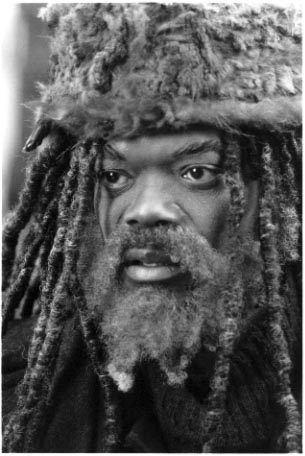
That dark, brooding, dreadlocked face staring back at you from film posters for The Caveman's Valentine is Romulus Ledbetter who is, by his own admission, insane, although his insanity does not prevent him from knowing and understanding things which the human sheep around him do not perceive -- just ask him -- or listen for his shouts. . . . "Rom" is a paranoid schizophrenic given to bellowing at Cornelius Gould Stuyvesant who, unseen, is the Power who controls most of the world from his office atop New York's Chrysler Building, from whence he sends out blue Y Rays and the insidious green Z Rays, of whose existence only Rom seems aware (although the audience can see them and the effect they have -- what else explains those bright green lime rickey cocktails the rich folks of Manhattan always seem to be drinking?). By the acclaim of others, Rom is also a musical genius, a gifted pianist and composer, a Julliard-trained dropout from the world who lives in a cave in New York's Central Park, a location which allows him to keep track of Stuyvesant's terrible plot to dominate people's minds.
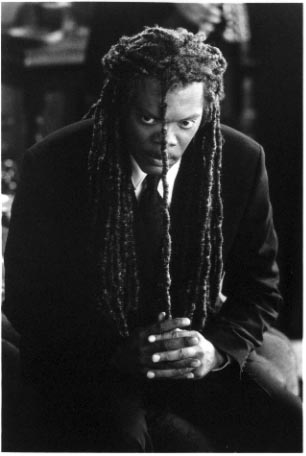
The Caveman's resistance to a social worker's insistence that Rom leave his cave for the warmth of a homeless shelter (Rom is not homeless, he often points out -- he has a home, his cave) is strengthened when he finds what he knows is a hideous Valentine for himself outside of his cave -- the frozen body of a young man, Scotty Gates (played by Sean MacMahon), left in a tree outside the cave entrance. The police say that Scotty was a drifter who climbed into the tree and froze to death, but Rom knows differently: he saw another man carefully and deliberately place Scotty's already lifeless body in the tree.
Unfortunately, the police refuse to believe Rom because he didn't actually witness the placement of the body himself, he just saw it happen on his television set -- a television set which is not connected to anything except Rom's inner vision. Despite the fact that his television set has no electrical power, no cameras leading to it, or anything of that sort, Rom knows that it shows him the reality which others can't see -- isn't the frozen "Valentine" from Cornelius Gould Stuyvesant proof of that? For the first time Rom begins to regret his insanity, because now he has proof of Stuyvesant's plots, but no one, not even his daughter Lulu (strongly performed by Aunjanue Ellis) or his friendly neighborhood bankruptcy lawyer, Bob (a stylish Anthony Michael Hall), will believe anything that he says unless he can provide them with what they consider "proof."
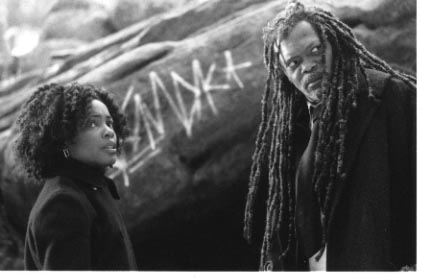
Fortunately, however, there is someone who believes The Caveman, Matthew (played by Rodney Eastman, who portrays the violently paranoid drug dealer in the independent film Random Acts of Violence), a drug-addicted street kid who was Scotty's lover. Matthew tells The Caveman what the police either don't know or will not admit: Scotty had been a model for the celebrated photographer David Leppenraub (Colm Feore, best known to American audiences for his "chilling" role as the villainous visitor in "Stephen King's 'Storm of the Century'"), and Leppenraub had, according to Scotty (as told by Matthew), physically and psychologically tortured him and even branded him with the sign of a heart, a further indication to Rom that Scotty's corpse was a macabre "Valentine" from Stuyvesant. Finally, according to Matthew, Scotty had tried to blackmail Leppenraub for reparations for his injuries, using a videotape of himself being tortured as leverage against the wealthy photographer.
Matthew comes to The Caveman because his lover had told him time and again that Rom was a true prophet ("The Voice"), and Matthew is confident that even if the police will not believe his story that Leppenraub murdered Scotty to cover up his own dark secrets, The Caveman will. Suddenly realizing that Leppenraub and his omnipresent photography of despairing angels are obviously tools of Stuyvesant, Rom agrees to help Matthew uncover proof that Scotty was murdered -- proof that even the police and his own family and friends will believe.

Standing against Rom is the mass of "sheep" whose disbelief and lack of confidence in him he must overcome in order to get directly at Leppenraub and those close to him, his sister, Moira (Ann Magnuson), and his live-in assistant cum documentarian, Joey (Jay Rodan). This task is not an easy one. How can an unshaven, unwashed social misfit who lives in a cave and screams at an unseen man in the Chrysler Building find damning evidence of torture and murder perpetrated by one of High Society's darlings of the moment, when not even the local Librarian (Deborah Lobban) will leave him in peace as he searches newspaper microfilm files for information about Leppenraub? -- As if Rom's discussion of the case, and his dubious lifestyle, too, with his absent wife, Sheila (a chic, stylish and seductive Tamara Tunie) was really disturbing other library patrons!
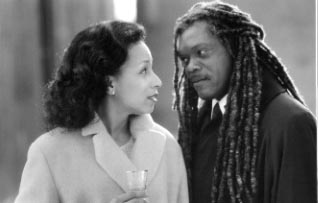
In order to prove his case against Leppenraub, The Caveman must re-create the shattered persona of Romulus Ledbetter; he must shave, bathe, and acquire an expensive suit and tie; he must overcome his inner doubts and submit to the guidance of the "moth/seraphs" who dance inside his skull, play the piano again and even finish an original composition (now dedicated to Leppenraub); most difficult for Rom, he must control his reactions to the Y Rays and the Z Rays and refrain from screaming defiance at Stuyvesant -- what is acceptable in Central Park or expected on the streets of New York is not allowable in penthouse apartments and luxurious country homes.
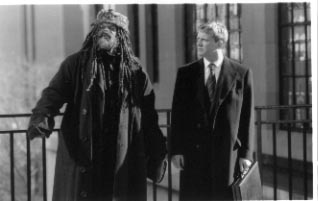
The far-reaching power of Stuyvesant seems to be too much for Rom, however, who succumbs to Stuyvesant's plot and vainly accuses Leppenraub of murdering Scotty without the necessary evidence. The reformed Romulus Ledbetter breaks down, and his friends and family again reject him, with only Sheila, unseen by others, visiting him to give advice, which tends to be that he simply give up his pursuit of evidence against Leppenraub. This The Caveman stubbornly refuses to do, and he realizes that if he cannot find evidence against the photographer in the conventional manner, he will, of necessity, revert to being what he is, an independent man whom Stuyvesant cannot control, and who pursues his own way in life by his own means, even if that includes screaming at the Chrysler Building. After all, didn't Matthew tell him that Scotty had called him, "The Voice"? Why would Scotty have called him that unless Scotty, who had scrawled a plea for help to The Caveman, even though they didn't know each other, had known that only Rom could help him? Romulus realizes that the way of the police will never bring Scotty's killer to justice; only the desperate foresight of a doomed boy and the insights of an insane prophet will bring down the murderer.
The Caveman's Valentine was written for the screen by George Dawes Green, from his Edgar-winning 1994 novel, and directed by Kasi Lemmons, best known for having directed Jackson in the excellent film Eve's Bayou. With The Caveman's Valentine, both Green and Lemmons firmly establish themselves as experts in the genre of the neo-Gothic drama. Working again with Lemmons is Eve's Bayou cinematographer, Amelia Vincent, and editor Terilyn Shropshire, who, with production designer Robin Standefer, choreographer Otis Sallid, composer Terence Blanchard, makeup artist Sylvain Cournoyer (Allan Apone for Samuel L. Jackson) and hairstylist Vincent Sullivan (Robert Stevenson for Jackson's Romulus Ledbetter) help to make The Caveman's Valentine a strong Oscarª contender.
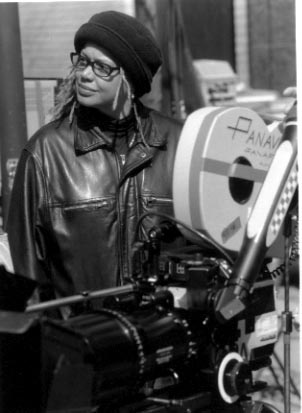
It is very tempting to write about the extent to which the female-dominated production team of The Caveman's Valentine breaks the stereotype of "a woman's film" or "a chick flick," and, undoubtedly, within the year some other writer will have a major "insight" into the significance of The Caveman's Valentine for "women in film," but it suffices this reviewer to advise his readers that they should not go to a screening of The Caveman's Valentine expecting it to be any sort of sub-standard production which was awarded to the women behind the camera so that the production companies could meet some socially acceptable and politically correct quota of employing women above "the glass ceiling." On the contrary, The Caveman's Valentine kicks a**! This is not just one of the best films we can expect this year, it is an excellent film, period.
As Romulus Ledbetter, Samuel L. Jackson gives what may well be the best performance of his career. Fans of Jackson's powerful work as the hitman "Jules" in Pulp Fiction may disagree, but The Caveman's Valentine shows that Jackson simply did not burst on the scene as a full-blown Great Actor whose performances can never again match his work as "Jules." Rather, Jackson's Romulus Ledbetter proves that he has grown and matured as an actor, and is capable of portraying the most intensely complex character from high to low, from genius to insanity, and from street person to suave Society artiste. With Ledbetter Jackson not only presents a three-dimensional character, but adds other dimensions as well -- the three dimensions of The Caveman's insanity. Cheryl Lemmons, M.D. is credited as "Psychiatric Consultant to Mr. Jackson," and his performance shows that he (and director Kasi Lemmons) were obviously paying attention. Particularly noteworthy is Jackson's powerful, understated, and realistic portrayal of his character's efforts to "maintain" his fragile persona as highly cultured musical genius Romulus Ledbetter without lapsing into his persona of the insane Caveman.
The insanity of Romulus Ledbetter and the insights which that insanity afford him, insights which are denied to the "sane" people who are unaware of what Rom knows, are thoroughly integrated into The Caveman's Valentine and Jackson's portrayal of The Caveman. Ledbetter's madness is not seen from outside himself, but from within his own mind. The audience does not simply watch Ledbetter lapse into his periodic bouts of paranoid schizophrenia, but, through the visual medium of film and through the work of composer Blanchard and supervising sound editor Jay Nierenberg, M.P.S.E., the audience experiences Rom's insanity, seeing and hearing what he does, to the extent that we are often caught by surprise, mistaking The Caveman's "reality" for our own. The Caveman would undoubtedly say that this proves that we are sheep under Stuyvesant's control, but I say that it proves that The Caveman's Valentine is an outstanding motion picture.
Perhaps the highest compliment to Lemmons's presentation of The Caveman's Valentine is the comment which this reviewer heard at the critic's screening of the film: "Now that I have seen the movie, I really want to go out and read the book!"

With the rise in theater ticket prices and the growing international audience of our page, our old NW2: Not Worth $2 (U. S. dollars) to W8: Worth $8 rating scale has become less useful than previously, so, in line with the scale used by the Internet Movie Database (IMDb) we have adopted a scale of 1 star to 10 stars, with "1 Star" being a VERY bad movie, and "10 Stars" being a movie classic. Our On-Line Reviewer, however, has gone where IMDb has never gone before: he has added a score of Zero for those movies which are so bad that they are not even good "camp" -- movies so bad that not even "Mystery Science Theater 3000" could could make them worth watching.
On this scale, anything rated "7 Stars" or above is definitely worth the cost of a theater ticket, "8 Stars" is worth standing in line to buy a ticket, "9 Stars" is worth standing in line in a driving rain rainstorm or severe heatwave or moderate windstorm to buy a ticket, and "10 Stars" is a movie worth driving hundreds of miles to go see -- at least in Dr. Shea's own opinion. Accordingly,

